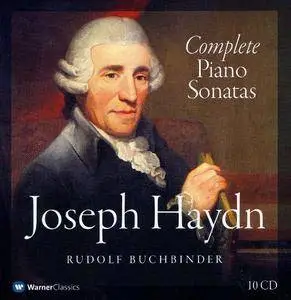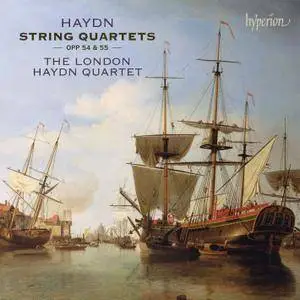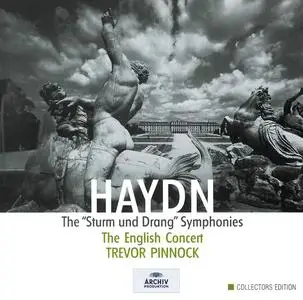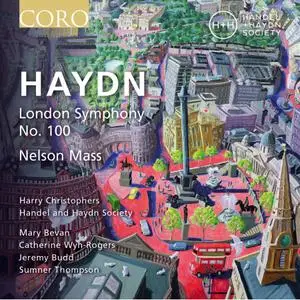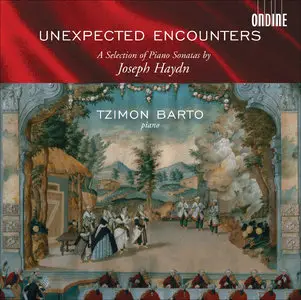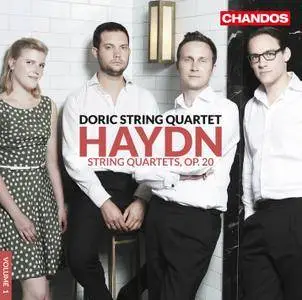Haydn
Markus Poschner, Manuel Hernandez-Silva, WDR Rundfunkorchester Köln - Haydn Opera Gala (2015) Music
Posted by ArlegZ at Nov. 8, 2024
Markus Poschner, Manuel Hernandez-Silva, WDR Rundfunkorchester Köln - Haydn Opera Gala: L'infedeltà delusa, La vera costanza (2015)
EAC | FLAC | Image (Cue & Log) ~ 396 Mb | Total time: 64:48+77:21 | Scans included
Classical | Label: Capriccio | # C5255 | Recorded: 2009, 2011
EAC | FLAC | Image (Cue & Log) ~ 396 Mb | Total time: 64:48+77:21 | Scans included
Classical | Label: Capriccio | # C5255 | Recorded: 2009, 2011
Although Joseph Haydn is still regarded principally as a master of instrumental music, he was also one of the forward-looking opera composers of his day, devoting a significant portion of his working life to the genre. As the opera director for Prince Esterházy, he oversaw more than a thousand opera productions at the Esterházy court, which included popular stage works of the time, as well as his own. These two operas are unusual and ahead of their time in that it is women who take centre stage. These female protagonists are people of real flesh and blood, strong, pragmatic, and clearly representative of the spirit of the Enlightenment.
Maximilian Hornung - Haydn, Azarashvili: Cello Concertos (2015) Music
Posted by tirexiss at Nov. 15, 2024
Maximilian Hornung - Haydn, Azarashvili: Cello Concertos (2015)
EAC | FLAC (image+.cue, log) | Covers Included | 59:03 | 315 MB
Genre: Classical | Label: Sony Classical | Catalog: 88843064532
EAC | FLAC (image+.cue, log) | Covers Included | 59:03 | 315 MB
Genre: Classical | Label: Sony Classical | Catalog: 88843064532
For his new album Maximilian Hornung chose the two cello concertos Joseph Haydn (1732-1809), which he recorded with the Potsdam Chamber Academy under the direction of Antonello Manacorda. The two most technically demanding concerts are among the top works that were composed in the 18th century for the cello. In particular, the rediscovery of the Cello Concerto in C major, which was thought to be lost until the 20th century, made in 1961 for a sensation in the music world.
George Li - Live at the Mariinsky: Haydn, Chopin, Rachmaninov, Liszt (2017) Music
Posted by ArlegZ at Nov. 8, 2024
George Li - Live at the Mariinsky: Haydn, Chopin, Rachmaninov, Liszt (2017)
EAC | FLAC | Image (Cue & Log) ~ 237 Mb | Total time: 68:56 | Scans included
Classical | Label: Warner Classics | # 9029581294 | Recorded: 2016
EAC | FLAC | Image (Cue & Log) ~ 237 Mb | Total time: 68:56 | Scans included
Classical | Label: Warner Classics | # 9029581294 | Recorded: 2016
This enthralling recital by the young American pianist George Li, silver medallist at the 2015 International Tchaikovsky Competition, marks his recording debut and launches a new relationship with Warner Classics. Captured at a live performance in the Mariinsky Concert Hall in St Petersburg, it presents a dramatically conceived programme of works by Haydn, Chopin, Rachmaninov and Liszt: a descent into deep darkness; re-emergence into the light, and a concluding, boisterous celebration.
Rudolf Buchbinder - Haydn: Complete Piano Sonatas (2006) (10 CDs Box Set) Music
Posted by murena at Nov. 6, 2024
Rudolf Buchbinder - Haydn: Complete Piano Sonatas (2006) (10 CDs Box Set)
EAC Rip | FLAC (Tracks+.cue, log) | 10 CD, 11:44:19 min | 2,3 Gb | Scans->62 mb
Genre: Classical / Label: Warner Classics
EAC Rip | FLAC (Tracks+.cue, log) | 10 CD, 11:44:19 min | 2,3 Gb | Scans->62 mb
Genre: Classical / Label: Warner Classics
It's not as if recordings of the 62 Piano Sonatas of Franz Josef Haydn are thick on the ground. Among the relative big names, there's Jeno Jando on Naxos and John McCabe on Decca. Among the less well-known names, there's Walid Akl on Koch Discover, Roland Batik on Camerata, Ronald Brautigam on BIS, Walter Olbertz on Berlin Classics, and Christine Schornsheim on Capriccio. And for those listeners with record players and aging memories, there's also the venerable Hungaroton cycle, the first complete recorded cycle, that coupled relatively well-known Hungarians like Zoltán Kocsis and Dezsö Ránki with nearly unknown Hungarians like János Sebestyén and the inimitable Zsuzsa Pertis.
The London Haydn Quartet - Joseph Haydn: String Quartets Opp 54 & 55 (2017) 2CDs Music
Posted by Designol at Aug. 5, 2022
The London Haydn Quartet - Joseph Haydn: String Quartets Opp 54 & 55 (2017) 2CDs
EAC | FLAC | Image (Cue&Log) ~ 750 Mb | Mp3 (CBR320) ~ 355 Mb | Artwork included
Genre: Classical | Label: Hyperion | # CDA68160 | Time: 02:33:13
EAC | FLAC | Image (Cue&Log) ~ 750 Mb | Mp3 (CBR320) ~ 355 Mb | Artwork included
Genre: Classical | Label: Hyperion | # CDA68160 | Time: 02:33:13
Haydn wrote the six quartets of Opp 54 and 55 in 1788, by now a celebrated composer across Europe and still opera Kapellmeister at Esterházy. These period instrument players, whose very name declares their affinity for Haydn, excel in the latest in their Hyperion series. Ever spry in fast movements, faultless in dexterity and intonation, they find a special warmth of feeling in the slower moments: the songful Adagio Cantabile of Op 55 No 1, the puzzling, melancholy Andante of Op 55 No 2, the dark, hymn-like first bars of Op 54 No 2’s Adagio, out of which the violin soars in almost improvised, bluesy reverie. Too many pleasures to enumerate. Try for yourself.
Trevor Pinnock, The English Concert - Haydn: The Sturm und Drang Symphonies (2000) (6CDs Box Set) Music
Posted by murena at Sept. 14, 2023
Trevor Pinnock, The English Concert - Haydn: The Sturm und Drang Symphonies (2000) (6CDs Box Set)
EAC Rip | FLAC (Tracks+.cue, log) | 06:10:23 min | 1,65 Gb | Scans->112 mb
Genre: Classical / Label: DG Archiv
EAC Rip | FLAC (Tracks+.cue, log) | 06:10:23 min | 1,65 Gb | Scans->112 mb
Genre: Classical / Label: DG Archiv
With 19 symphonies spread across six CDs, this major reissue set of Trevor Pinnock's performances (with The English Concert) of a substantial selection of Haydn's "Sturm und Drang" symphonies is outstanding in every regard. Derived from the German literary movement that affirmed that emotionalism and dark-hued urgency powerfully reflected the human condition, "Sturm und Drang" (literally "Storm and Stress") exerted a profound impact upon the evolution of the Classical symphony, especially in Haydn's hands. No one with an interest in either the period or the composer can possibly afford to be without this set. The performances are simply magnificent! Pinnock's periodist band sounds brilliantly accomplished throughout, and the recorded sound is clear, impactful, and detailed.
Harry Christophers, Handel and Haydn Society - Haydn: Symphony No. 100; Nelson Mass (2020) Music
Posted by ArlegZ at April 12, 2021
Harry Christophers, Handel and Haydn Society - Haydn: Symphony No. 100; Nelson Mass (2020)
EAC | FLAC | Image (Cue & Log) ~ 290 Mb | Total time: 64:47 | Scans included
Classical | Label: Coro | # COR16181 | Recorded: 2020
EAC | FLAC | Image (Cue & Log) ~ 290 Mb | Total time: 64:47 | Scans included
Classical | Label: Coro | # COR16181 | Recorded: 2020
Experience two grand classics, alive with all the excitement and verve of their very first performances. Thrill to one of Haydn’s masterful ‘London’ symphonies that wowed England’s capital – the smash hit ‘Military’, so-called for intense depictions of the clash of arms and ferocious roar of war. In the epic Nelson Mass Handel and Haydn Society's magnificent chorus and soloists join the orchestra in this homage to the heroic admiral who helped to vanquish Napoleon.
Tzimon Barto - Unexpected Encounters: A Selection of Piano Sonatas by Joseph Haydn (2009) Music
Posted by Designol at March 7, 2024
Tzimon Barto - Joseph Haydn: Piano Sonatas Nos. 10, 38, 42, 60 (2009)
EAC | FLAC | Image (Cue&Log) ~ 259 Mb | Mp3 (CBR320) ~ 191 Mb | Scans included
Genre: Classical | Label: Ondine | # ODE 1154-2 | Time: 01:17:21
EAC | FLAC | Image (Cue&Log) ~ 259 Mb | Mp3 (CBR320) ~ 191 Mb | Scans included
Genre: Classical | Label: Ondine | # ODE 1154-2 | Time: 01:17:21
Released in the 200th anniversary year of Haydn’s death, this new release features pianist Tzimon Barto playing a selection of the great Classical composer’s piano sonatas. Tzimon Barto is celebrated for his "refreshing" approach (American Record Guide) to known repertoire. Barto’s highly personal approach to these works – which he has devoted himself to for much of his career – enables the listeners to make their own "unexpected encounters" with these works. Making no attempt to be "historically correct", Barto focuses instead on his discovery of impressionistic elements, as well as inspiration drawn from theatre and painting of the period. Tzimon Barto is recognised as one of the most radiant and unique personalities in the music world. His two previous recordings for Ondine – keyboard pieces by Rameau (ODE1067-2) and piano works by Ravel (ODE10952) – have received high levels of acclaim; critics have hailed Barto’s musical maturity, superb technique, and endless colour palette.
Manfred Huss, Haydn Sinfonietta Wien - Joseph Haydn: Opera at Eszterháza: Arias; La Circe (2009) Music
Posted by ArlegZ at Aug. 7, 2022
Manfred Huss, Haydn Sinfonietta Wien - Joseph Haydn: Opera at Eszterháza: Arias; La Circe (2009)
EAC | FLAC | Tracks (Cue & Log) ~ 327 Mb | Total time: 71:31 | Scans included
Classical | Label: BIS | # BIS-1811 SACD | Recorded: 2008, 2009
EAC | FLAC | Tracks (Cue & Log) ~ 327 Mb | Total time: 71:31 | Scans included
Classical | Label: BIS | # BIS-1811 SACD | Recorded: 2008, 2009
Haydn composed more than twenty operas, mainly for the sumptuous theatre at Eszterháza, the palace of his long-time employers, the princes of Esterházy. Even so, his work in the operatic field remains largely neglected. This disc focuses on an even more closely guarded secret: the so-called 'insertion arias' that Haydn wrote for inclusion in operas by other composers. The rarely, if at all, recorded music includes Haydn's three contributions to La Circe, an opera pasticcio which combined music by several composers, and six of the surviving insertion arias. Among these is Infelice sventurata, written for an opera by Cimarosa, and one of Haydn's finest arias, here movingly performed by Miah Persson. The Swedish soprano shares the greater part of the programme with the Swiss tenor Bernard Richter.
Doric String Quartet - Franz Joseph Haydn: String Quartets, Op.20 (2014) 2CDs Music
Posted by Designol at July 7, 2022
Doric String Quartet - Franz Joseph Haydn: String Quartets, Op.20 (2014) 2CDs
EAC | FLAC | Image (Cue&Log) ~ 655 Mb | Mp3 (CBR320) ~ 350 Mb | Scans included
Genre: Classical | Label: Chandos | # CHAN 10831 | Time: 02:30:03
EAC | FLAC | Image (Cue&Log) ~ 655 Mb | Mp3 (CBR320) ~ 350 Mb | Scans included
Genre: Classical | Label: Chandos | # CHAN 10831 | Time: 02:30:03
Haydn’s six Op. 20 string quartets are milestones in the history of the genre. He wrote them in 1772 for performance by his colleagues at the Esterházy court and, unusually, not specifically for publication. Each one is a unique masterpiece and the set introduces compositional techniques that radically transformed the genre and shaped it for centuries to come. Haydn overturns conventional instrumental roles, crafts remarkably original colours and textures, and unlocks new expressive possibilities in these works which were crucial in establishing the reputation of purely instrumental music. The range within the quartets is kaleidoscopic. From the introspective, chorale-like slow movement of No. 1 via the terse and radical quartet No. 3 in G minor to the comic spirit of the fourth in D major, each of the quartets inhabits a distinct musical world. For many, this is some of the greatest music Haydn ever wrote. Playing these seminal works is one of the world’s finest young ensembles, the Doric String Quartet.

